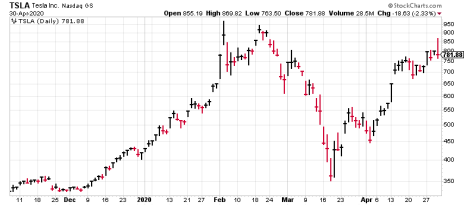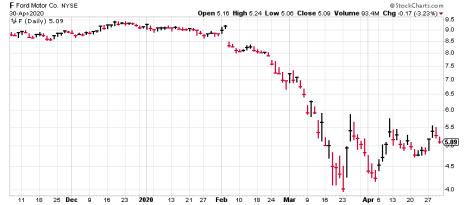The best is still to come for Tesla (TSLA). And that means it’s a great time to buy Tesla stock.
Tesla (TSLA) last week released an excellent first-quarter earnings report:
Revenues were $5.99 billion, up 32% from the same quarter the year before but down 19% from the last quarter of 2019 thanks to coronavirus-related shutdowns.
Deliveries were 88,400, up from 63,000 the year before.
Automotive gross margins grew to 25.5%, up from 20.2% the year before.
[text_ad]
Model Y deliveries began significantly ahead of schedule, and actually contributed to profits.
Cash and cash equivalents were $8.1 billion at the end of the quarter, up $1.8 billion from the previous quarter.
And the company remains committed to its goal of 500,000 vehicle deliveries this year.
All told, it’s a picture of a big company that is still growing fast and improving operationally, despite the challenges posed by the coronavirus restrictions.
The Competition
General Motors (GM) last week announced that it’s suspending its dividend, as first-quarter revenues were down 7% from the year before—and sales in China were down 43%. There’s no word yet on whether the plan to spend $2.2 billion to convert the company’s old Detroit-Hamtramck plant to build electric vehicles is on target, but it’s clearly at risk, simply because so many other companies have cut back their electric vehicle plans.
Ford (F), which reported a first-quarter net loss of nearly $2 billion, last week announced that its plan to make a Lincoln-branded electric vehicle in cooperation with Rivian—a plan that was announced just three months ago—had been called off. Rivian, which had previously received more than $2.8 billion in investments from Ford, Amazon (AMZN) and others, and has an order to build 100,000 electric delivery vehicles for Amazon, will presumable soldier through, but at the moment, with up to $5 billion in losses looming in the second quarter, Ford is dropping out.
Meanwhile, over in Germany, Daimler’s Mercedes-Benz last week announced that it is killing its program to develop passenger cars powered by hydrogen fuel cells that generate electricity—in part a sign of the cost-cutting efforts now required by these companies and in part an admission that Elon Musk had it right a decade ago. Mercedes has been working on fuel-cell vehicles for more than 30 years—but now concedes that building hydrogen cars is too costly.
All told, it’s a picture of legacy manufacturers being forced to back off on their vehicle electrification efforts at exactly the time that Tesla is gaining traction—and that’s why Tesla stock has been so strong recently.
The Future of TSLA
So what comes next?
For Ford and GM and Daimler and all the legacy manufacturers who are stuck with fossil fuel operations and aging workforces, the years ahead will continue to bring hard choices.
For Rivian and Amazon, the future looks bright. Amazon’s delivery vehicles, for example, will be optimized for their task, and include digital instruments integrated with Amazon’s logistics management that give the driver exactly what he needs to do his job. These include not only routing guidance while driving but also the ability to use Amazon Alexa from the cargo bay to get guidance on sorting packages.
For TSLA, the sky’s the limit, as the company is now the clear leader in automotive technology, as well the fastest-growing major auto manufacturer on earth.
And the best is yet to come (in my opinion)!
Next year will bring the first deliveries of the Tesla Semi—admittedly, two years behind schedule.
Tesla’s Berlin Gigafactory, slowed a bit by the coronavirus, should break ground soon, and be producing batteries, powertrains and Model Y vehicles later this year.
The revolutionary Cybertruck, which may begin deliveries in late 2021 (though most likely in 2022), has more than 500,000 $100 preorders. One analyst expects the truck will account for 15% of Tesla’s vehicle output in its first full year.
But where will the truck be built?
Elon Musk says the factory, which will also build the Model Y, will be located “more than halfway” across the country going from west to east. Nashville is already in talks with TSLA, but Texas is a strong possibility, Wichita last week submitted a bid with $1 billion in incentives, Joplin, Missouri wants a shot, and other candidates run all the way up to unused old automobile factories in Michigan‚ though my sense is that the realities of winter that far north make Michigan unlikely.
Beyond Vehicles
But Tesla is more than vehicles, and to me, this is the most exciting aspect of its whole story. With its solar roofs generating low-cost renewable power from the sun and its battery packs enabling the storage of that energy (or energy from any low-cost source) until it is needed, TSLA has the keys that will enable a revolutionary new clean electric infrastructure, increasingly distributed and increasingly immune to outages from any disruption. It will take time, of course, but for investors with a long-term horizon, I think the potential is too big to ignore.
[author_ad]





